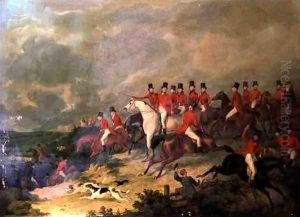F.C. Turner Paintings
Francis Calcraft Turner, commonly known as F.C. Turner, was an English painter specializing in horse racing scenes, hunting scenes, and animal portraits, particularly horses. Born in 1782, he was active during a period when horse racing and fox hunting were among the most fashionable and celebrated social activities in British aristocratic circles, and his work often reflects the enthusiasm and elegance of these sports.
Turner received his artistic training in London, where he honed his skills in depicting horses with accuracy and dynamism. He exhibited at the Royal Academy from 1812 to 1850, and also showed his works at the British Institution. His paintings were well-received for their attention to detail, understanding of equine anatomy, and ability to capture the excitement of the race or the hunt.
Throughout his career, Turner developed a reputation for his sporting paintings. His works often featured well-known racehorses of the day, along with portraits of jockeys and owners, set against the backdrop of iconic racecourses such as Epsom and Ascot. Turner's hunting scenes are equally notable, as they vividly depict the English countryside, the colorful attire of the huntsmen, and the frenetic energy of the hunting hounds.
In addition to his paintings, Turner was also known for his engravings and illustrations. He contributed to publications like 'The Sporting Magazine,' providing visual accompaniments to the articles on sporting events and figures. His illustrations helped to popularize the sports he depicted and served to disseminate his work to a broader audience.
F.C. Turner's legacy as an artist is closely tied to the portrayal of English sporting life in the early 19th century. Although not as widely known today as some of his contemporaries, his paintings remain of interest to collectors and historians of equine art and sporting culture. Turner passed away in 1850, leaving behind a body of work that continues to celebrate the pomp and pageantry of the sporting traditions of his time.


